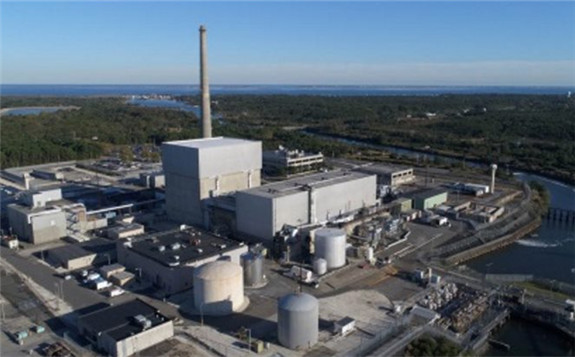Holtec Decommissioning International (HDI) - a wholly-owned subsidiary of Holtec International - has announced decommissioning progress at the Oyster Creek nuclear power plant in New Jersey and the Pilgrim plant in Massachusetts. All fissile material in Oyster Creek's reactor building has now been transferred to the on-site Independent Spent Fuel Storage Installation (ISFSI), while at Pilgrim the transfer of the used fuel in wet storage to its ISFSI is proceeding at a record rate.
 All fissile material has now been removed from Oyster Creek's reactor building (Image: Exelon)
All fissile material has now been removed from Oyster Creek's reactor building (Image: Exelon)
At Oyster Creek, 2433 used fuel bundles have been safely loaded into Holtec canisters and transported to the ISFSI in less than 5 months, with peak transfer rate reaching two-and-a-half canisters per week, HDI said. The reactor building is now devoid of any fissile material. The protected area at the site has now been reduced from approximately 150 acres to 6 acres with the US Nuclear Regulatory Commission's (NRC's) authorisation, making the task of the security workforce substantially easier and a more concentrated effort.
Risk management and innovative use of tooling has allowed Oyster Creek to perform reactor internal segmentation in parallel with moving fuel to dry storage, HDI said, with only three canisters needed for the loading and storage of Greater-Than-Class C waste. A systematic approach to site building demolition is ongoing at Oyster Creek using an innovative process that involves preparing the impacted buildings for open air demolition, it added. Hazardous materials - such as asbestos and lead - are stripped out and components in the structures are decontaminated or encapsulated to ensure containment of contaminants.
Some of the structures already dismantled at Oyster Creek include the air ejection off-gas building, the torus water storage tank, the radioactive waste storage tank and several other structures originally scheduled for demolition in 2024 and 2025. Pragmatic decontamination efforts have enabled up to 95% of waste from the torus water storage tank and components such as the hydraulic control units to be salvaged as scrap metal. HDI says it envisages recycling as many spare parts and components as possible. The site has completed the shipment of over 132,000 feet (over 40,000 metres), over five million pounds (2268 tonnes), of waste to date.
Pilgrim's progress
At Pilgrim, the transfer of the used fuel in wet storage to the ISFSI is proceeding at the rate of two multipurpose canisters per week, which like Oyster Creek, is an unprecedented rate in the industry, HDI said. The company expects Pilgrim to be entirely defuelled by November.
Greater-Than-Class C waste, currently located in the dryer-separator pit, will be loaded into non-fuel waste containers following the fuel campaign and moved to the new ISFSI pad in December. In addition, the focus on risk mitigation and removal has led to a number of buildings and structures being removed earlier than expected.
The removal of the main emissions stack, a firewater storage tank and former plant operations support buildings has been completed, which has led to increased staging areas for waste removal, as well as enhanced security. This early staging has enabled earlier than planned shipping of some low-level radioactive materials to Waste Control Specialists' disposal site in Andrews County, Texas. Over 1.4 million pounds (635 tonnes) of material has now been removed from the Pilgrim site, including the 36 concrete shield blocks that used to cover the reactor vessel when in operation.
"We should be proud that we have made great progress in both projects while meeting in full measure what I call the seven critical metrics of excellence, namely, minimal crew dose, no spread of contamination, no OSHA violation, no release to the environment, no worker injury, total schedule adherence and minimised quantity of waste for disposal," said HDI President Kelly Trice.
Although licensed to operate until 2029, Exelon had decided in 2010 to retire Oyster Creek early after revisions to New Jersey's water use rules would have required it to build new cooling towers at an estimated cost of more than USD800 million. The 619 MWe single-unit BWR plant was the oldest operating nuclear power plant in the USA when it was shut down on 17 September 2018, after 49 years of electricity generation. Holtec formally took over ownership of Oyster Creek after its subsidiaries completed the transfer and acquisition from Exelon Generation on 1 July 2019.
The 680 MWe boiling water reactor at Pilgrim shut down in May 2019 after 47 years of operation and was acquired by Holtec that August after the NRC approved the transfer of the plant's licence, including its existing dry cask used fuel storage installation. It was the second US decommissioning project to be acquired by Holtec, following Oyster Creek in New Jersey.
Holtec has also announced purchase-sale agreements for Indian Point in New York, which closed in April 2020, and Palisades in Michigan, which is due to close in 2022.